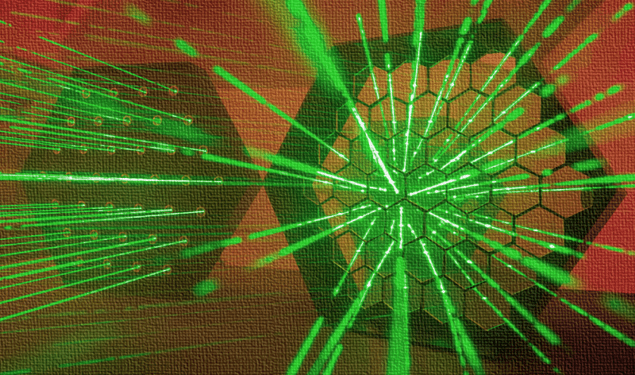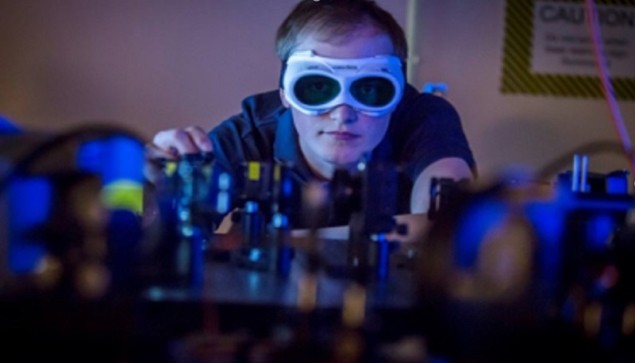High-power lasers promise new defence strategy
16 May 2022 Sponsored by QinetiQ
 |
Physicists at QinetiQ are developing systems that combine and control high-energy laser beams to provide a powerful and cost-effective countermeasure against drones and other uncrewed objects
Around the world interest is growing in using high-power laser beams to disable airborne invaders such as drones and other uncrewed objects. These so-called directed-energy systems have the potential to damage or destroy small aerial devices at a fraction of the cost of launching conventional defence missiles or munitions. They have the added advantage that they can be reused many times to counter multiple attacks as well as the growing threat of drone swarms.
At QinetiQ, a UK-based technology company specializing in defence and security solutions, around 10 years of research effort into the physics underpinning these directed-energy systems has demonstrated enough potential to start building and testing practical prototypes. “We have taken a high-risk, high-reward approach to developing these systems,” says Richard Hoad, capability area lead for novel effectors and resilience at QinetiQ. “Our company and our customers in the defence sector have significantly increased their investment to enable us to prove that our solution is as effective in a wide range of real environments as it is in testing.”
We currently have around 20 people working on all aspects of these systems, and we now need more laser physicists to supplement and boost the team.Richard Hoad, QinetiQ
That increase in funding, combined with the need to migrate the technology from lab-based demonstrators to fully integrated systems, is generating demand for more physicists and engineers within QinetiQ’s High Energy Laser teams. “We currently have a highly capable team working on all aspects of these systems, and we now need more laser physicists to supplement and boost the team,” he says. “There are some great opportunities to get involved with cutting-edge technology that’s on the verge of becoming a game-changing military capability.”
Scalable benefits Photonics focus: optical scientists at QinetiQ’s research campus in Malvern have been perfecting an electronic phase-control technique to enable the coherent combination of multiple laser beams (Courtesy: QinetiQ)
Photonics focus: optical scientists at QinetiQ’s research campus in Malvern have been perfecting an electronic phase-control technique to enable the coherent combination of multiple laser beams (Courtesy: QinetiQ)
 Photonics focus: optical scientists at QinetiQ’s research campus in Malvern have been perfecting an electronic phase-control technique to enable the coherent combination of multiple laser beams (Courtesy: QinetiQ)
Photonics focus: optical scientists at QinetiQ’s research campus in Malvern have been perfecting an electronic phase-control technique to enable the coherent combination of multiple laser beams (Courtesy: QinetiQ)The key objective has been to design a scalable architecture, combining multiple kilowatt-class lasers to enable the brightness of the beam to be easily dialled up or down. For robustness the team has chosen to exploit established fibre-laser technologies, originally developed for industrial materials processing, with the biggest challenge having been to find an effective way to combine and control the output from many different fibre-laser amplifiers.
“We need to make sure the power reaches the target, which may be several kilometres away,” says Hoad. “That means we need to steer and point the laser with high precision, while also compensating for the effects of atmospheric turbulence on the propagation of the beam.”
Various technologies could be used to combine the beams, but QinetiQ has opted to pursue an electronic phase-combining technique that allows critical parameters such as the shape, central brightness and spot size of the laser beam to be more precisely controlled. While similar in theory to phased-array radar, the much shorter wavelengths of infrared lasers require greater engineering precision and efficient algorithms to enable accurate and high-speed electronic control.
Physicists at QinetiQ’s R&D campus in Malvern have been charged with perfecting this coherent phase-combining technique. “As well as the physics challenge we now have an engineering challenge to show that our approach can deliver a robust solution in many different environments,” says Hoad. “External factors such as vibration and positional stability will make a huge difference on how well you can control the phasing of the output beam.”
Integration efforts Aiming high: Richard Hoad, capability lead for novel effectors and resilience at QinetiQ, is looking for physicists and engineers who want to exploit their skills to deliver real-world systems (Courtesy: QinetiQ).
Aiming high: Richard Hoad, capability lead for novel effectors and resilience at QinetiQ, is looking for physicists and engineers who want to exploit their skills to deliver real-world systems (Courtesy: QinetiQ).
 Aiming high: Richard Hoad, capability lead for novel effectors and resilience at QinetiQ, is looking for physicists and engineers who want to exploit their skills to deliver real-world systems (Courtesy: QinetiQ).
Aiming high: Richard Hoad, capability lead for novel effectors and resilience at QinetiQ, is looking for physicists and engineers who want to exploit their skills to deliver real-world systems (Courtesy: QinetiQ).Meanwhile, over at QinetiQ’s Cody Technology Park in Farnborough, efforts are focused on integrating the core phase-control technology with high-power laser sources, as well as alignment optics and a power source. A large systems-integration facility is available for indoor testing, allowing the team to evaluate the effect of the phase control on the output beam.
Longer term, QinetiQ believes that directed-energy systems exploiting either high-energy lasers or high-power radio-frequency transmitters could be used more generally for wireless power transfer. For example, beaming energy at a co-operative target, such as a drone equipped with a receiving system, would make it possible to recharge an onboard power-storage device.
Other possible scenarios include emergency response situations, where power needs to be supplied to critical infrastructure without running cables. The European Space Agency, meanwhile, is also interested in using the technology to beam high-bandwidth data into space. Wireless power-transfer technology could even support the mass-market adoption of electric vehicles, providing top-up charges from systems installed along the motorway. “This research is still very speculative, but it shows the enormous potential of directed-energy technology,” comments Hoad. “It could be really interesting for some applications.”
Developing such high-power systems requires expertise in many different aspects of laser science. One is to understand how the atmosphere affects the propagation of high-energy laser beams, since turbulence close to the ground and changing weather conditions make it challenging to control and target the beam. Laser safety is another crucial area of research, with experts working to evaluate the hazards and risks of firing high-power lasers into the sky, such as understanding what happens when some of the energy is reflected back from the target.
Open opportunities
“Taking the technology from R&D to the development of practical systems puts more emphasis on the engineering, as well as understanding the wider consequences of using directed-energy technology,” comments Hoad. “That means we need to grow our capability, and we now have roles available in both Malvern and Farnborough for people who want to apply their skills and see their research exploited in real-world systems.”
We are open minded about the amount of previous experience a candidate can offer, since we provide dedicated training for new recruits.Richard Hoad, QinetiQ
QinetiQ is looking for scientists or engineers who can demonstrate a working knowledge of photonics and laser physics. “We are open minded about the amount of previous experience a candidate can offer, since we provide dedicated training for new recruits to enable them to work with our technology and our facilities,” he says. “New team members have the opportunity to move around the business, so an optical physicist working primarily in Malvern might spend time in Farnborough to see how the technology gets integrated, while our high-energy engineers would go to Malvern to understand how the core technology works.”
QinetiQ is also keen to support staff who wish to further their academic training, whether for an undergraduate university course or a sponsored PhD. Hoad himself joined the business as a technician apprentice, studying part-time to obtain first a Master’s and then a PhD, while several of his team members are currently working towards their doctorates. “We are building stronger links with academia, and sponsoring students is a great way for us to that,” he says.
Candidates who are fresh out of university can also join through QinetiQ’s two-year graduate training scheme, which assigns each new entrant to a “home” business while also offering six-month placements in other departments. “There are plenty of options within QinetiQ for people who are interested in laser science,” says Hoad. “As well as our work on high-energy sources, other groups are focusing on areas such as LIDAR and optical ground systems for communications.
Indeed, with more than 6000 employees worldwide, QinetiQ offers a range of opportunities for career progression. Scientists who become experts in their field are recognized through a fellowship scheme, with Fellows and Senior Fellows receiving an annual stipend to pursue their own research. A career development framework for technical staff also encourages external collaborations with industry and academia, continuing professional development, and conference attendance – all with the objective of building networks that can help to advance the technology.
“Most of our projects involve a partner in industry or the defence sector,” comments Hoad. “We need to join forces to move this technology along.”Visit Physics World Jobs to view and apply for the latest positions at QinetiQ. Alternatively, visit the QinetiQ’s careers page here to view and apply for roles
Sponsored by QinetiQ
from physicsworld.com 26/5/2022

Δεν υπάρχουν σχόλια:
Δημοσίευση σχολίου